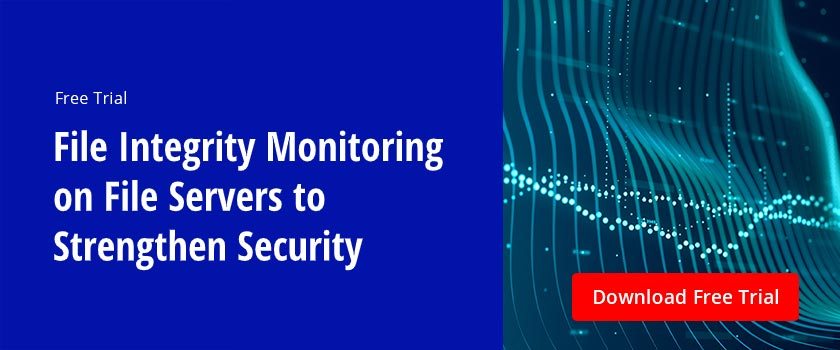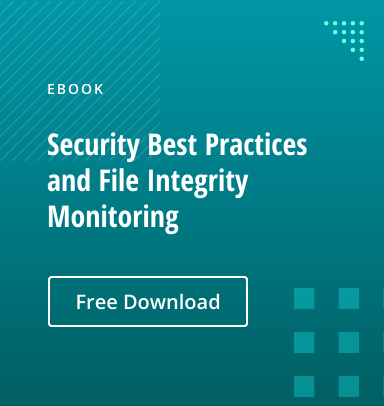File integrity monitoring (FIM) audits file and system changes to ensure they are legitimate, reducing the risk of data compromise and helping organizations meet standards like PCI DSS, HIPAA, and NIST. Effective FIM supports the CIA triad by safeguarding integrity, enhancing threat detection, and streamlining compliance audits. While standalone FIM tools can be costly and noisy, integrated solutions that track configuration drift, audit changes, and provide clear reporting deliver stronger security and efficiency.
File integrity monitoring is crucial for the security of an organization’s information systems, as well as for regulatory compliance. This article will explore what file integrity monitoring is and help you find the right file integrity monitoring software solution for your organization.
What Is File Integrity Monitoring?
File integrity monitoring (FIM) is a critical part of an enterprise’s data-centric security strategy. FIM is the process of auditing all attempts to access or modify files and folders containing sensitive information, and checking whether the activity is legitimate, authorized, and in alignment with business and legal protocols. By proactively detecting inappropriate and unauthorized changes and access events, you can minimize security breaches. Accordingly, FIM is a requirement of many compliance regulations.
File Integrity Monitoring and the CIA Triad
The CIA triad refers to the confidentiality, integrity and availability of data:
- Confidentiality — Limiting access to sensitive data to authorized parties
- Integrity — Ensuring that data remains accurate, consistent, and trustworthy throughout its life cycle
- Availability — Making sure the IT infrastructure is smoothly operational and free from bottlenecks, internal system conflicts and any other issues that might disrupt access to critical files
As its name suggests, file integrity monitoring pertains directly to the integrity piece of a data security strategy.
Why You Need File Integrity Monitoring
FIM helps organizations detect improper changes to critical files on their systems, which reduces the risk of data being stolen or compromised, which would cost you time and money in lost productivity, lost revenue, reputation damage, and legal and compliance penalties.
Core FIM Functionality
When looking for a FIM solution, be sure to consider how well each tool delivers on each of the primary objectives of FIM.
Change Management
A FIM solution should improve data security by continuously monitoring both of the following:
- Changes to your organization’s critical files and folders.
- Changes to your file system configuration. It should enable you to easily compare the current configuration of a system to your organization’s baseline or other known good state.
Threat Detection
A FIM solution should improve your threat intelligence and intrusion detection. It should facilitate the processes of monitoring user activity and reviewing access permissions so you can maintain the security model of least privilege. If a user initiates a suspicious access attempt or makes inappropriate changes to sensitive files, a systems administrator can quickly mitigate this vulnerability by removing that user’s access privileges.
Compliance Auditing
FIM is required or recommended by many regulatory standards, including the following:
- HIPAA recommends continuously auditing data security and access controls as a best practice.
- FISMA specifies file integrity monitoring as one of its core requirements.
- NIST encourages incorporating real-time FIM as part of a baseline data security policy.
- The NERC CIP implementation guidance document requires FIM capabilities.
- PCI DSS requires integrity monitoring for awareness of suspicious changes to critical data and system files, along with file comparisons on a weekly basis at minimum.
File Integrity Monitoring Software
You can implement file integrity monitoring either by investing in a standalone FIM tool or by leveraging your existing suite of IT monitoring tools and resources. Here are the key benefits and drawbacks to each approach.
Using a Standalone FIM Tool
Purchasing and deploying a dedicated solution can offer you the assurance that you have all your FIM bases covered. It may seem like a simple and obvious way to demonstrate your FIM compliance to executive management or regulatory auditors, but there are several notable concerns with dedicated FIM solutions that you’ll want to be aware of:
- High costs — According to Gartner research, organizations find standalone FIM tools to be expensive in relation to the practical features that they provide. In fact, many organizations report using only a small subset of their FIM tool’s capabilities. The most commonly used capabilities include change monitoring and reporting.
- Alert fatigue — Standalone FIM tools are complex products that must be deployed correctly to provide accurate monitoring. Faulty deployments can result in the FIM tool reporting both authorized and unauthorized changes as security concerns. The constant stream of false positives causes significant operational challenges and inefficiencies, and security teams may miss real threats buries in all the noise.
Achieving FIM through Integrated Technologies
Another option is to implement FIM through an integrated approach rather than a single costly tool. With this approach, you think of FIM not as an isolated endeavor but as an organic extension of your overall information security strategy.
These are the key capabilities that you need for effective file integrity monitoring:
- Monitoring of system configuration changes to ensure your applications, services and cloud network remain uncompromised and meet your baseline criteria
- Auditing of file changes across servers, including file creation, modification and deletion
- Detailed reporting on changes to facilitate analysis and troubleshooting
Netwrix solutions provide a powerful suite of capabilities for implementing file integrity monitoring to strengthen your security posture. Specifically, Netwrix Change Tracker will:
- Monitor your systems for any changes from your standard configurations and notify you immediately about any drift.
- Remove change noise to empower operations teams to focus on truly anomalous events.
- Provide full visibility into changes to critical system files across your entire infrastructure, including details about who changed what and when and where each change occurred, all in human-readable format.
- Reduce the time and effort you spend on compliance reporting with 250+ reports covering CIS, NIST, PCI DSS, CMMC, STIG and NERC CIP.



